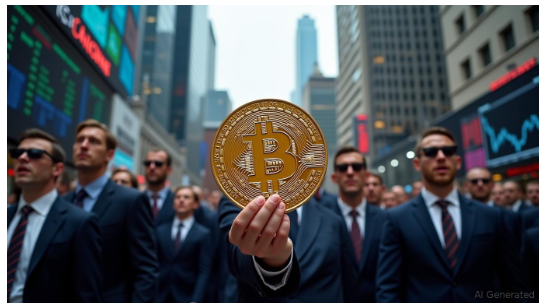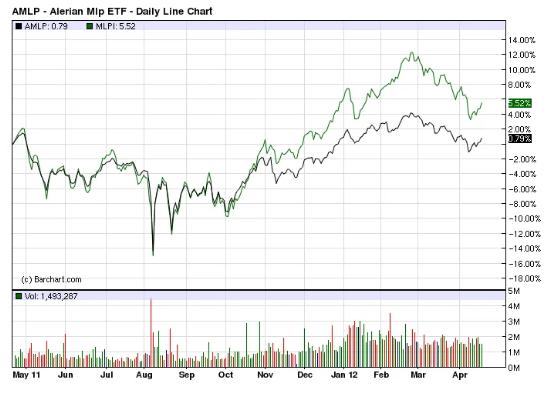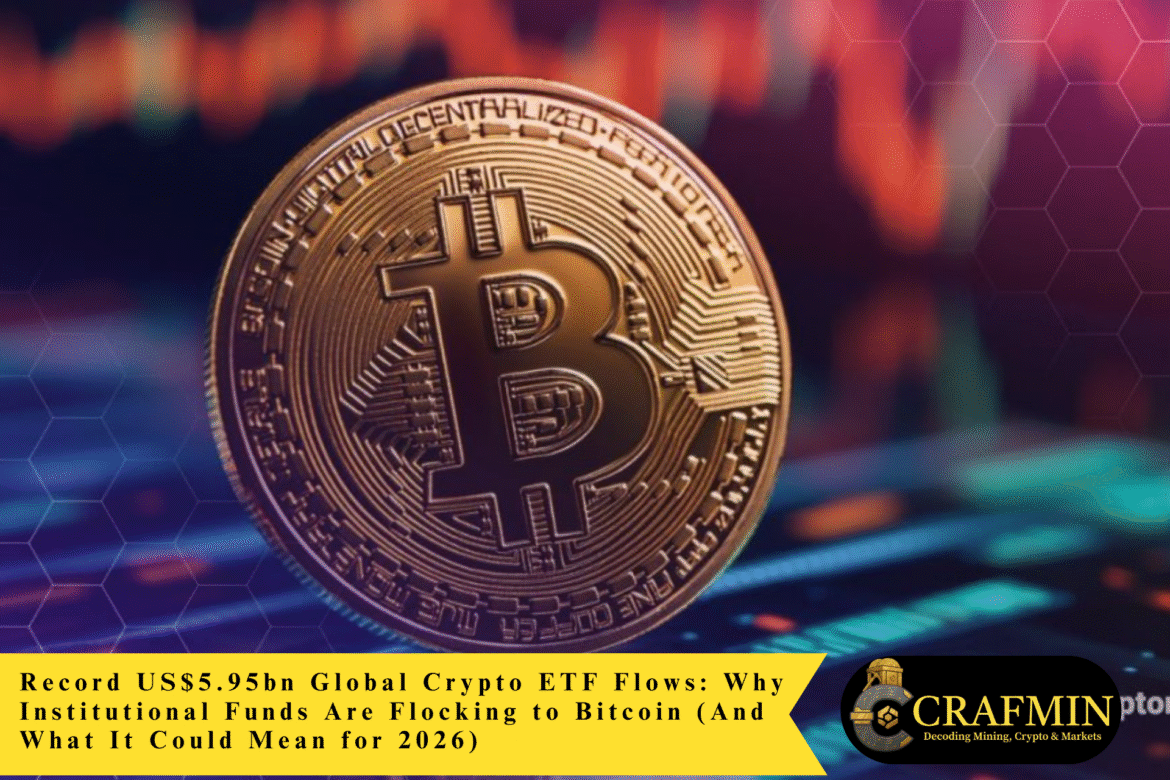Global cryptocurrency exchange-traded funds (ETFs) register a record US$5.95bn of net inflows in seven days: an all-time high weekly high. The surge places Bitcoin at the center of the action, with the United States being the source of the majority of the new money, and important European markets also registering strong inflows. Flows are preceded by a fresh risk-on mood in crypto prices and fresh institutional adoption stories. (Reuters)
Why The Size Is Significant: Speedy Takeaway
A near-US$6bn week pour into crypto ETFs is no small retail anomaly. It’s institutional funds in action at scale. Institutions employ ETFs to move volumes of money quickly with assurance in the legal wraps and reporting requirements that they know. As the ETFs absorb this money, they have two effects on the market: support of the price of the underlying asset and a legitimating signal for other treasury desks and institutional allocators. CoinShares’ weekly data convey the size and extent of the flow and the reconfiguring character of the composition of the market. (coinshares.com)

US$6bn into crypto ETFs shows big players are officially in. (Image Source: AInvest)
The Numbers Behind The Headlines
US$5.95bn: total weekly inflows to global crypto ETFs (week through early October 2025). (Reuters)
Most of that capital flowed into Bitcoin, with Ether, Solana and XRP contributing importantly. CoinShares’ weekly note analyses these flows and regional leaders. (coinshares.com)
The biggest source of the inflows came from the United States, followed by Switzerland and Germany: a sign that European demand and U.S. product drives are afoot. (Reuters)
What Caused The Stampede: Simple, Pragmatic Reasons
Regulated On-Ramps Operate. Spot Bitcoin ETFs and regulated wrappers enable pension funds, insurance treasuries, and wealth managers to invest directly without custody/legal contortions. Improved regulators’ guidance in large markets reduces compliance friction and invites more risk-averse money to experiment. (Reuters)
Macro Drivers: Dollar Dynamics and Diversification. Geopolitics trade tensions and protracted equity valuations lead allocators to non-correlated assets. Institutional investors are among those that view Bitcoin as a store-of-value proxy or portfolio diversifier, particularly if the U.S. dollar is weakening. (Reuters)
Price Momentum and Story. Rising prices attract momentum flows. Where news and price reinforce each other, ETF inflows move into high gear: a feedback cycle that pressures allocators afraid to be left behind to play. (FastBull)
Liquidity and Product Availability. ETF liquidity makes it possible for large traders to enter and exit with less market effect than OTC or spot markets. Institutional desks prefer ETFs because they are easier to handle within existing workflow. (coinshares.com)
A Short Story: A Fund Manager’s Decision in Five Lines
Imagine a mid-sized Australian super fund. Their CIO is holding a report: equities are expensive, fixed income yields are volatile, and gold is rising. Their investment committee wants diversification that preserves purchasing power. A spot Bitcoin ETF with governance controls wraps into the approved list. They take a small, tactical slice: not because everybody’s convinced yet, but because the ETF wrapper is amenable to governance controls and the risk scenario is manageable. That small slice, multiplied across hundreds of funds, becomes the billions we’re seeing. (This is illustrative but it mirrors real allocation mechanics highlighted by flows data.) (coinshares.com)
Regional Colour: Who’s Buying
United States
The largest single source of inflows: US-listed and US-linked ETPs drew most of the US$5.95bn. Institutional access and product recognition are responsible for much of this preponderance. (Reuters)
Switzerland & Germany
Both posted record or near-record inflows, reflecting continental Europe’s increasing demand for ETPs and crypto in conventional market environments. (Reuters)
Other Markets
Canada, Nordics and selective Asian desks trade opportunistically at the mercy of local wrappers and custody. CoinShares’ regional breakdown paints the detailed picture. (coinshares.com)
Institutional Profiles: Who’s Actually Behind The Flows?
Asset Managers and Family Offices: Prefer ETFs for reporting and governance ease.
Hedge Funds and Macro Desks: Use ETFs strategically for exposure, fuelled in periods of macro uncertainty.
Corporate Treasuries and Insurers (Early Adopters): Corporate cases mentioned include corporates considering crypto as part of diversification within the treasury or strategic reserves, niche but growing. (FastBull)

The flows are led by asset managers, hedge funds, and a few early corporate adopters. (Image Source: The Economic Times)
Market Mechanics: How Such Inflows Affect Price and Volatility
ETF flows buy real Bitcoins (or exposure through futures, in some vehicles). Large and long flows soak up on-hand spot liquidity, driving price higher: the bull channel. Institution-sized flows also can be the equivalent of larger intraday moves, a large buyer drives price higher, profit-taking or rebalancing drives it down. The net effect: higher price floors over time, with intermittent volatility. CoinShares’ analyses repeatedly display this liquidity–price relationship. (coinshares.com)
Risk Checklist for Institutions and Retail Investors
Regime Risk. Regimes presently ETF-friendly may shift. Institutions are keeping a watch on policy risk. [Reuters]. (Reuters)
Concentration Risk. Excess capital, concentrated in a narrow basket of ETFs, can put secondary-market liquidity or redemption mechanics under pressure. CoinShares and other studies indicate liquidity monitoring as key. (coinshares.com)
Counterparty and Custody Risk. Some custody issues are mitigated by ETFs but residual custody and prime-broker relationships remain significant.
Macro Correlation Can Spike. In some stress events, crypto moves in sync with risk assets. Diversification is less certain.
2026 Outlook: A Window That Looks Out
Greater Institutional Investment Is On The Horizon. Once a handful of big institutions report risk-adjusted returns in their own portfolios, peer funds will imitate. The path to a multi-hundred-billion dollar world of Bitcoin funds appears closer when weekly flows hit as much as nearly US$6bn. [FastBull]. (FastBull)
Product Innovation Intensifies. Expect to see more ETF derivatives: currency-hedged, custody-enhanced, or multi-asset blockchain ETFs for customized institutional mandates. Regulators get smarter also. [CoinShares Research Blog; Financial Times]. (coinshares.com)
Market Structure Changes. Institutional flows surge, prompting exchanges, custodians and prime brokers to build infrastructure, enable settlement, insurance and reporting. That makes it easier for even more adoption. [Financial Times]. (Financial Times)
Macro Makes The Call. When central banks reverse and currencies come under pressure, need for substitute assets may drive further in 2026. Or a strong economic rebound could reduce need to put money into digital assets.
What Institutions Will Do Next (Realistic Action)
- Small, Governed Pilot Investments. Most managers start with a small, focused initial allocation in a “risk assets” sleeve. They monitor quarterly performance and operational drag. Spot ETFs provide an easy administrative solution for the initial allocation. (coinshares.com)
- Tactical Rebalancing And Overlay Techniques. Macro desks and multi-asset funds will use ETFs in dynamic allocation, hedges in futures, options overlays, or cross-asset hedges to manage drawdowns.
- Additional Treasury And Corporate Tests. More corporate treasuries are experimenting with small crypto exposures as a hedge of last resort for purchasing-power protection or strategic exposure. (Reuters)
- Customization Of Products And Niche ETFs. Look ahead to product proliferation: currency-hedged ETFs, multi-crypto baskets, volatility-managed ETFs, and insurance- or enhanced custody-overlay ETFs. (Financial Times)

Coming next: test allocations, tactical ETF moves, treasury trials, and niche crypto ETFs. (Image Source: Issuu)
Simplified Supply–Demand Model (How ETFs Affect Bitcoin Supply and Price)
This is a bone-minimum overview showing mechanism, not price forecasting:
- ETF inflows → demand for underlying Bitcoin.
- ETFs accepting new money see fund managers buying spot BTC or settling with authorized participants. That corners hand supply from exchanges and OTC desks.
- Drop in liquid supply → pressure on price.
- Feedback loop: price rise attracts more demand.
- Redemptions and liquidity risk remain an offset.
A Quick, Quantitative Summary (Descriptive)
If ETF inflows are US$6bn/week worldwide on average, and ETFs buy the equivalent spot BTC, and retail selling and miner supply in a week total, say, US$3bn, then net absorption absorbs US$3bn of liquidity each week. That supply shortage is sufficient to propel prices upward until new selling is reached. The real figures vary; this is the direction force. CoinShares’ report captures exactly this kind of demand absorption last week when it was one for the books. (coinshares.com)
Three 2026 Scenarios: Bull, Base, Bear (Triggers To Watch)
Bull Scenario: “Institutional Adoption Accelerates”
Result: Bitcoin and key crypto markets continue to advance; ETF AUM jumps substantially; price makes higher highs throughout 2026.
Key Drivers: Continuing scale ETF inflows; regulatory stability in major markets; additional weakening of real yields or fresh dollar weakness; large corporates directing crypto into treasuries. (Reuters)
Base Case: “Measured Institutional Adoption”
Outcome: Bitcoin is an intermittent but tiny portfolio sleeve. Volatility diminishes over time but episodic spikes persist. ETFs compound AUM cumulatively without runaway price appreciation.
Key Drivers: Ongoing but not runaway flows; minor product innovation; macro tailwinds that ebb and flow.
Bear Case: “Policy Shock Or Liquidity Reversal”
Result: Redemptions or regulatory reversals initiated suddenly squeeze prices and challenge the liquidity characteristics of ETFs. Short-term anguish, long-term structural take-up maybe preserved.
Key Drivers: Sudden mass regulator crackdown in a fundamental market; unexpected macro shock that provokes risk-off; severe selling by large institutional investor. (coinshares.com)
Tactical Watchlist: Dimensions To Watch Weekly
- Net ETF inflows/outflows (weekly). The best-known leading indicator. Released weekly by CoinShares and is closely tied with price action. (coinshares.com)
- Regional Breakdown (US/Europe/Switzerland/Germany). Large inflows in one region raise regional policy importance. (Reuters)
- Exchange Spot Liquidity And Order Books. Lowering order books enhances price action.
- Custody And Insurance Announcements. Insurance and custody expansion announcements signal declining operational risk. (Financial Times)
- Macro Indicators: Relative yields, USD index, CPI surprises.
Frequently Asked Questions
Q: How good is the US$5.95bn estimate?
A: CoinShares’ weekly fund-flows reporting and primary wire agencies corroborate the sum for the week of early October 2025. (coinshares.com)
Q: Is all retail money?
A: No. These flows of ETF reflect institutional allocation, in addition to high-net-worth and retail demand. Product structure and geography reflect strong institutional participation. (Reuters)
Q: Will Bitcoin still be skyrocketing thanks to ETFs?
A: ETFs are a cleaner conduit for demand and can buffer prices, but there is still an effect from macro trends, liquidity, and sentiment. ETFs reduce frictions for purchasers, which can extend bullish cycles; but they do not remove all risk. (coinshares.com)
Q: Buy now?
A: Not investment advice. The risk tolerance, time horizon, and diversification requirements need to be addressed by investors. Governance for institutional investors will be easier with the ETF wrapper; retail, cost, custody, and strategy are the issues.
Q: How do ETFs acquire Bitcoin? Do all ETFs purchase real BTC?
A: Some ETFs buy spot Bitcoin and hold it in custody, while others engage in futures or synthetic exposure. In the recent record week, CoinShares and media quote that products tracking spot dominated a good portion of the inflows, and thus managers are buying underlying BTC to hedge ETF exposure. See the ETF prospectus for product mechanics. (coinshares.com)
Q: Do ETF inflows make Bitcoin “less risky”?
A: No, they provide legitimacy and lower custody tensions but volatility in prices still persists. Operational risk may be mitigated by ETFs on the part of institutions but market risk remains. Institutional block trade ownership can stabilise as well as emphasize direction according to flows. (Financial Times)
Q: Can ETFs over-concentrate too much Bitcoin in a single manager?
A: In fact. Last week’s FT journalism illustrates how focused products in this example certain of the larger US ETFs can embody enormous Bitcoin exposures. Such focus raises system-wide issues about redemptions, manager behavior and market effect. (Financial Times)
Short Guide for Australian Investors (Simple, No-Fuss)
Select Vehicle: ETF vs direct. ETFs simplify custody and overlay onto existing brokerage and superannuation infrastructure. Spot BTC purchase involves wallet custody and private key risk management.
Verify Domicile And Tax Treatment: Offshore ETFs will be taxed differently and subject to another regime of dividend withholding. Consult a tax expert.
Think In Terms Of Size Of Holding And Governance: Treat crypto like any new asset class: limit, maintain governance records, and define rebalancing rules.
Be Aware Of Liquidity And Spreads: Some ETFs are lightly traded; monitor bid–ask spreads, especially during periods of unusual volatility.
Utilize Regulated Institutions And Brokers: Choose platforms with clear regulatory oversight, secure custody partners and insurance where available. (coinshares.com)
Practical Lessons; For Veterans And Newbies
Retail Investor: ETFs provide exposure with no custody complexity. Start small, treat it as high-volatility capital, and watch weekly inflows as a market indicator. [CoinShares]. (coinshares.com)
Financial Advisers: Deliver client education on custody differences, tax and risk. Illustrate the mechanics of ETFs to demonstrate how institutional-grade wrappers can reduce operational risk. Watch flows and macro indicators to track client expectations. [Reuters; CoinShares]. (Reuters)
Institutional Investors: Pilot small sizes, leverage good governance and stress test redemption arrangements. Consider concentration risk where particular ETFs demonstrate dominant AUM levels; include several providers to lessen manager concentration. (Financial Times)
Crypto Professionals (Exchanges, Custodians): Double down on settlement reliability, insurance and open audit procedures. Institutional capital values operational certainty as much as theoretical returns. (Financial Times)

Simple for retail, educate for advisers, test small for institutions, build trust for crypto firms. (Image Source: Yahoo)
Ethical And Regulatory Watch: What Could Reverse The Outlook Overnight
Regulatory Clarifications Or Reversals. A clear regulatory imprimatur can hurry inflows; a tightening or additional compliance burden can slow development. [Reuters; CoinShares]. (Reuters)
Market Incidents. Cyber crime incursions, custody losses or catastrophic exchange failures can wipe out institutional demand in a flash.
Macro Shocks. Unannounced rate shifts, unanticipated recessions or geopolitics shocks will redirect whole capital away from risk assets, including crypto.
Sources Of Increased Flow And What They Say (Brief)
- CoinShares fund flows week (06 Oct 2025): Reports US$5.95bn in flows; US leads by US$5.0bn; Bitcoin and Ether capture most flows. The key data for the lead. (coinshares.com)
- Reuters (Oct 7, 2025): Aggregates CoinShares data, attributes flows to dollar weakness and macro nerves, and releases regional breaks. (Reuters)
- Financial Times (latest): Examines concentration risk in giant ETFs and reveals BlackRock dominance of the US universe; a structural force in market dynamics. (Financial Times)
- Market Outlets & Commentary: Yahoo Finance, The Block and ETF research pages include contextual flow data, product information and market sentiment snapshots. (The Block)
Also Read: Who Writes the Rulebook Authorship? Tokenisation and Market Democracy
Final Thoughts: What the US$5.95bn Week Really Means
The weekly record inflow is not a fate, it is a milestone. It means that open, regulated vehicles have the ability to attract scale institutional capital. That does change something for price, yes, but more so for the ecosystem: improved custody, increased product innovation, and deeper market plumbing. For 2026, the most important variables aren’t headlines or sentiment. They’re policy clarity, product diversification and whether inflows are permanent as a base component of institutional portfolios. If weekly inflows return to normal in quantities above earlier cycles, the path to larger adoption becomes shorter. If flows reverse, markets push elasticity and infrastructure. Either way, the market has been altered. Institutional capital has a ready point of entry into crypto now. How they do it will determine the next chapter. (Reuters)
Activated internal reference links: Reuters, CoinShares and Financial Times references in the text have been linked to the source pages cited above.

